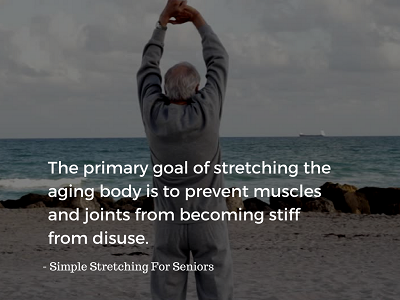 It may seem like stretching and flexibility is a straightforward thing… and to a large extent it is, when you’re young. However, as one ages, it’s more important to take necessary precautions when engaging in physical activities, including stretching.
It may seem like stretching and flexibility is a straightforward thing… and to a large extent it is, when you’re young. However, as one ages, it’s more important to take necessary precautions when engaging in physical activities, including stretching.
When you were young, if you felt a slight pain in your knee, you’d probably just throw a few kicks into the air and the problem would have resolved itself. Try that when you’re in your seventies and you might end up dislocating your hip.
You have no choice but to be more careful in your approach. Below you’ll find eight rules of stretching that you should abide by if you’re in your senior years. While they are applicable to any age, they’re more important when you’re older.
1 – Check with Your Doctor First
Yes, even stretching sessions should come with your doctor’s approval. Some seniors may have back problems or joint issues that can be aggravated when certain stretches are done. So, your doctor will be the best person to advise you here.
2 – Always Warm Up First
It may seem contradictory that you need to warm up before stretching since most people assume that stretching is warming up. In reality, warming up refers to some light cardio that gets your blood circulation going.
A brisk walk for 5 minutes should warm your joints and body up enough for you to stretch. The muscles will not be cold and much more responsive to your stretching.
3 – Breathe
While stretching, it’s important to maintain a slow steady breath. This will calm your body down. The body’s parasympathetic response will kick in and your muscles will relax. This will make them more pliable and you can stretch better.
4 – Take It Slow
When you first start on a flexibility training program, you may find that your range of motion is limited. Do not try to rush the process and speed things up by taking on more than you can handle.
Aim to stretch gently and to the point where you feel some tension but not discomfort. Every day, try to make a little progress. Over time your range of motion will increase, and you’ll be more flexible.
5 – Hold the Stretch
When you stretch, you need to hold the static stretch for 20 seconds to a minute. This will help your body relax into the stretch. It’s important to hold the stretch for at least 20 seconds to get the lengthening benefit that the muscles need.
6 – Don’t Push Past Pain
If it hurts, stop. Do not make the mistake of thinking pain is gain. With flexibility, you must take the slow and steady approach.
7 – Easy In, Easy Out
When doing stretches, you want good form. Ease into the stretch gradually and gently… and ease out of it just as smoothly. As a senior, you do not want to engage in jerky, ballistic movements.
8 – Consistency is Key
Aim to stretch 4 to 7 times a week. Ideally, stretching can and should be done daily. It’s not strenuous. So, most seniors will be able to do about 10 to 20 minutes a day without any problem.
Remember these 8 points and make stretching a part of your daily routine. Your body will thank you for it.






